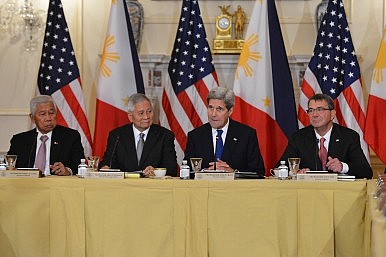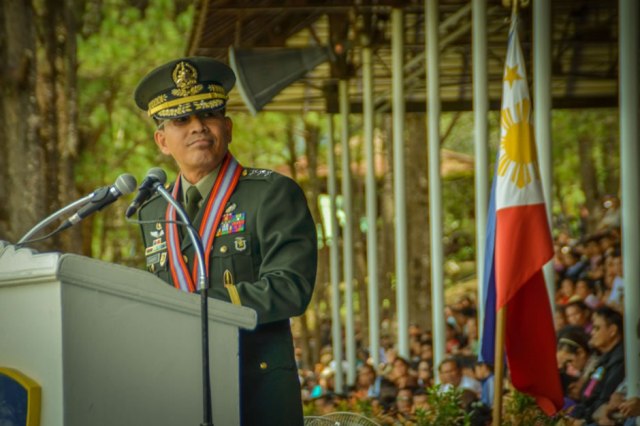From the Daily Tribune (Jan 16):
Noy bribed by Washington on EDCA—LFS
President
Aquino could have been allegedly “bribed” by Washington over his lobbying of the Enhanced
Defense Cooperation Agreement (EDCA) which was recently ruled as constitutional
by the Supreme Court despite criticisms and the lack of ratification from the
Senate as required by no less than the Constitution, which alleged bribe was
worth $300 million, militant groups charged yesterday.
Youth group
League of Filipino Students (LFS) said that its suspicion stems from a New York
Times (NYT) report published on Sep. 20, 2015 that noted Aquino’s
solicitation of $300 million from the US
government to finance defense efforts against potential threats from China.
It was
during that period last year when tensions over contested territories against Beijing and Manila
were high.
“In private talks, the government of President Aquino had pressed the United
States for up to $300 million in aid this year, arguing that it needs a
substantial buildup of planes and ships to deter Chinese expansionism,
according to a senior Philippine official who spoke on condition of anonymity
because United States officials have asked to keep the talks confidential,” the
NYT news story said.
The same report also said that US President Barack Obama refused the said offer
because of fears of corruption in the Republic, and that the Philippines too,
is the biggest aid recipient of the US in Southeast Asia.
Indonesia and other South
East Asian countries get more by way of US aid and military aid.
In a phone interview, Charisse Bañez, LFS chairman, told The Tribune it is very
likely that Aquino’s lobbying paid off, which is a “form of pawning national
sovereignty to the hands of Uncle Sam”.
Bañez dared Aquino to talk about the allegation and “not just let it pass as if
it’s another joke that he can’t stand” since “it wasn’t seemingly considered a
serious story”.
“Have you been bribed, Mr. President? We don’t think that this is a mere joke
since you now appear as the American government’s most diligent ally and puppet
of the US here in the (Southeast Asian) region,” Bañez said as a response to
The Tribune’s query on what her group has to say to such accusation.
She also debunked EDCA apologists’ claim that the said treaty will be helpful
to the Philippines if ever the tension against China heightens further by
saying that the US government will ultimately benefit the most in the EDCA
despite Philippine state security heads’ belief that it will help in the
modernization of the Armed Forces of the Philippines (AFP).
“Contextually, the EDCA is very disadvantageous to the Philippines
because it opens wide the gates to US bases which was collectively rejected by
the people in 1991.
Why? Are we preparing for war against China? Our
legal battle before the UN tribunal and the efficient support of the international
community will help us win a winnable fight. The subliminal option lobbied by
the Aquino government and perhaps by Obama is one that will surely put the Philippines
into a definite defeat. Either way, it will be the US
and China
that are going to win. WE are merely pawns and the EDCA allows it,” Bañez said.
“Modernization from the help of Americans? What a joke! The help they are
providing are second hand recycled pieces that could be sold to junk shops. If
that’s the standard of Noynoy and the AFP, well, they’re obviously swallowing
blatant insults on our nation’s dignity,” she added.
The LFS leader also quipped that if US
assistance is helpful, why has the Visiting Forces Agreement (VFA) not been
effective in stopping Chinese incursions and construction of man-made islands -
which turns out to be naval bases - in the disputed portions of the South China
Sea (West Philippine Sea).
The EDCA allows US troops into the Philippines for extended stays and
allows them to build and operate facilities on Philippine bases, for both
American and Philippine fores. It is also a supplemental agreement to the
previous VFA.
The agreement also allows US forces and contractors to operate out of “agreed
locations,” which are defined as: “facilities and areas that are provided by
the Government of the Philippines through the AFP and that United States
forces, United States contractors, and others as mutually agreed”.
These identified locations which include Clark, Subic, Fort
Magsaysay and facilities in Palawan,
will be the site of new US
bases. These facilities are not ordinary civilian structures. Control over
these bases will remain with the US, it was pointed out.
Meanwhile, Anakpawis Party list Rep. Fernando Hicap warned that with the EDCA’s
identified locations, it is paving the way for a return of the US military
bases.
“Clearly the Aquino and the US
government wasted no time to exploit the SC decision in favor of EDCA on their
plan for creating de facto American military bases in PH soil. The so called
agreed locations not only serve as a rotational venue for US servicemen but it
will also be used as warehouse of their destructive weapon stockpile,” Hicap
said.
Hicap also said that just like the US Embassy, the said selected military
locations will be exclusively under US military control even it will be built
inside major AFP camp adding that AFP officials even high ranking government
officials cannot easily access to inspect these facilities without the US
government’s permission.
“We are deeply wary that vessels such as carriers and subs may contain nuclear
weapons which under the constitution clearly prohibited,” he added.
The EDCA is effective for an initial period of ten years, and thereafter, it
shall continue in force automatically unless terminated by either Party by
giving one year’s written notice through diplomatic channels of its intention
to terminate the agreement (Article XII, Sec. 4 of EDCA).
Noy: EDCA a “practical” tool to improve AFP
President Aquino yesterday shielded the EDCA and played up the pact as a “very
practical” way of improving the Armed Forces of the Philippines (AFP) rather
than engage in a mind game to threaten anyone in keeping ties with the United States.
Aquino, in a press conference at the Manila Hotel, echoed the Palace statement
on the measure, describing it as an “enhancement” of the Philippines and United States’ defense
capabilities.
“The basic logic behind EDCA is interoperability, and anybody who is reasonable
will see that this agreement is an enhancement of both our countries’ abilities,
rather than a threat to anyone else,” he said.
“All the modern hardware carries a significant price tag; yet with EDCA, we
have a chance to try the cutting-edge equipment and see just how suitable they
are to our needs, without having to buy them first,” Aquino added.
He added that while the AFP can learn from an advanced military force, the US
“gets to learn how to make do with fewer resources, which in a conflict
situation is always a high probability if not an intense possibility.”
The President’s statements came after militants rained tirades on the
administration’s perpetration of ties with the United States which was more
described as Aquino being a puppet of the Federal government.
Groups have scored Aquino over his soft stance with Americans and have lamented
the Supreme Court’s (SC) recent decision attesting to the validity of EDCA as
an executive agreement than a treaty which its critics suggest.
While Aquino was focused on justifying the EDCA, the Philippines irked China
anew after the High Tribunal’s decision on the agreement, which the Chinese
state claimed would only “escalate tensions and undermine peace and stability
in the (Asia-Pacific) region.”
“It seems very peculiar that the Philippines, which stopped hosting two of the
largest overseas US military bases in the early 1990s, invited the US troops
home again, despite strong domestic criticism, at a time when the situation in
the South China Sea has stabilized,” a commentary on the official Xinhua News
Agency site said Wednesday afternoon.
“It is easy to deduce that Manila, which has long been involved in a dispute
with Beijing over claims on some South China Sea islands, appears to be now
turning to Uncle Sam to back its ambition to counter China,” it added.
The EDCA seeks to increase military presence in the Philippines through
allowing entry of American forces at a rotational basis. It also sought to
allow the Federal forces to make use of Philippine military bases, which some
claimed would spell the return of US bases in the country.
In 1992, the Senate voted to eject foreign military bases in the country, as it
poses danger of being targets of the enemies made by the United States.
http://www.tribune.net.ph/headlines/noy-bribed-by-washington-on-edca-lsf






